
Cassia fistula, also known as golden shower, purging cassia, Indian laburnum, kani konna, or pudding-pipe tree, is a flowering plant in the family Fabaceae. The species is native to the Indian subcontinent and adjacent regions of Southeast Asia. It is the official state flower of Kerala state and Delhi UT in India. It is also a popular ornamental plant and is also used in herbal medicine.
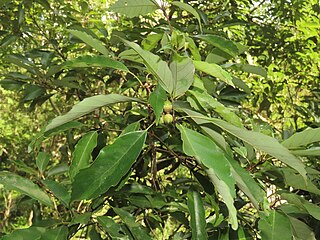
Quercus glauca, commonly called ring-cupped oak or Japanese blue oak, is a tree in the beech family (Fagaceae). It is native to eastern and southern Asia, where it is found in Afghanistan, Bhutan, China, northern and eastern India, southern Japan, Kashmir, Korea, Myanmar, Nepal, and Vietnam. It is placed in subgenus Cerris, section Cyclobalanopsis.

Calystegia sepium is a species of flowering plant in the family Convolvulaceae. It has a subcosmopolitan distribution throughout temperate regions of the North and South hemispheres.

Multipurpose trees or multifunctional trees are trees that are deliberately grown and managed for more than one output. They may supply food in the form of fruit, nuts, or leaves that can be used as a vegetable; while at the same time supplying firewood, adding nitrogen to the soil, or supplying some other combination of multiple outputs. "Multipurpose tree" is a term common to agroforestry, particularly when speaking of tropical agroforestry where the tree owner is a subsistence farmer.

Erythrina variegata, commonly known as tiger's claw or Indian coral tree, is a species of Erythrina native to the tropical and subtropical regions of eastern Africa, the Indian subcontinent, northern Australia, and the islands of the Indian Ocean and the western Pacific Ocean east to Fiji.
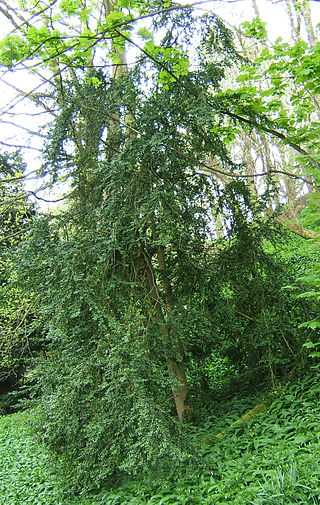
Buxus sempervirens, the common box, European box, or boxwood, is a species of flowering plant in the genus Buxus, native to western and southern Europe, northwest Africa, and southwest Asia, from southern England south to northern Morocco, and east through the northern Mediterranean region to Turkey. Buxus colchica of western Caucasus and B. hyrcana of northern Iran and eastern Caucasus are commonly treated as synonyms of B. sempervirens.

Senegalia catechu, previously known as Acacia catechu, is a deciduous, thorny tree which grows up to 15 m (50 ft) in height. The plant is called khair in Hindi, and kachu in Malay; the Malay name was Latinized to "catechu" in Linnaean taxonomy, as the species from which the extracts cutch and catechu are derived. Other common names for it include kher, catechu, cachou, cutchtree, black cutch, and black catechu.

Senegalia laeta, the gay acacia or daga, is a legume found in the family Fabaceae. It was formerly included in the genus Acacia.

Vachellia oerfota is a perennial shrub or tree which is native to Africa, Asia and the Middle East. Among other things, it is used in making beverages. It grows 1–5m high. It is an important legume tree commonly browsed by goats and camels in Africa. It is valued as a fodder by pastoralists.

Corymbia maculata, commonly known as spotted gum, is a species of medium-sized to tall tree that is endemic to eastern Australia. It has smooth, mottled bark, lance-shaped to curved adult leaves, flower buds usually in groups of three, white flowers and urn-shaped or barrel-shaped fruit.

Gliricidia sepium, often simply referred to as gliricidia or by its Spanish common name madre de cacao, is a medium size leguminous tree belonging to the family Fabaceae. It is an important multi-purpose legume tree, with a native range from Mexico to Colombia, but now widely introduced to other tropical zones.

Gliricidia is a genus of flowering plants in the legume family, Fabaceae and tribe Robinieae. Its native range is Mexico to Peru, but Gliricidia sepium has been widely introduced to other tropical zones.

Great Indian Bustard Sanctuary is a wildlife sanctuary for the great Indian bustard at Solapur, Maharashtra, India. The land is drought-prone and semi-arid. It is in the Deccan thorn scrub forests ecoregion.
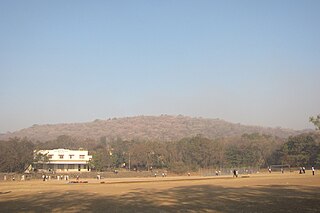
Vetal Hill is a prominent hill in the city limits of Pune, India. The hill is the highest point within the city limits, with an elevation of 800 meters (2,600 ft). The temple of Vetala is located on the top of the hill from which the hill derives its name. The Indian Forest Department maintains an observation deck near the temple. The hill is also known by its Marathi name, Vetal Tekdi.

Macrosaccus gliricidius is a moth of the family Gracillariidae. It is known from Central America and the West Indies.
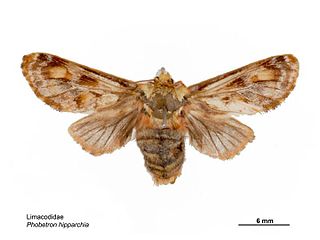
Phobetron hipparchia, the monkey slug, is a moth of the family Limacodidae. It is found in Mexico, Panama, Ecuador, Colombia, Venezuela, the Guianas, Brazil and Argentina.
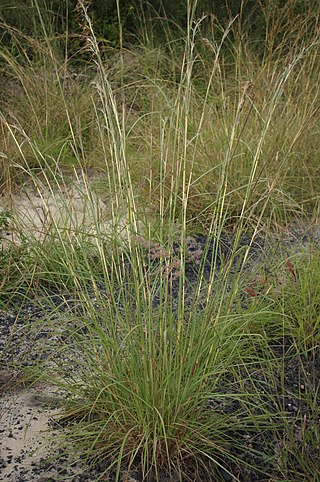
Hyparrhenia rufa is a species of grass known by the common names jaraguá, jaraguá grass, and giant thatching grass. It is native to Africa and it is widespread in the world as a cultivated forage and fodder for livestock and a naturalized and sometimes invasive species.
G. maculata may refer to:

Dronagiri Fort is a fort in Navi Mumbai's Raigad district, Maharashtra, India.
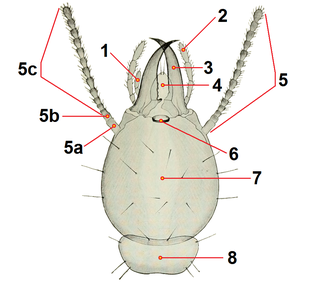
Coptotermes ceylonicus, is a species of subterranean termite of the genus Coptotermes. It is native to India and Sri Lanka. It is a common wood destroying termites, which damage to logs, woodens structures of both natural and man-made. It is a pest of many economically valuable trees such as Hevea brasiliensis and Camellia sinensis, and also an inhabitant of Anacardium occidentale, Cocos nucifera, Ficus fergusonii, Gliricidia sepium, Grevillea robusta, Madhuca longifolia, Tamarindus indica and Theobroma cacao.

















